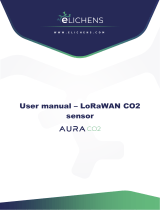7 - Operation
Channel: The radio frequency channel. If several LoRa/Sky networks exists within the same area, a
different frequency should be selected for each network. The radio frequency is 433.3 + 0.2 MHz *
(channel-1), i.e. the first channel is 433.3 MHz, second 433.5 etc. The channel 4 uses 433.9 MHz which is
the most crowded frequency on this band, so it should be avoided.
Quality: This setting has three options affecting the reliability of the packet delivery:
• Unidirectional (default): This device will transmit each reading once not expecting any
acknowledgement. If the packet is lost due to a collision with another transmission or any
disturbance, it is lost.
• Bidirectional: After transmitting a packet, this device will listen for an acknowledgement from a
receiver and retransmit up to two times if not getting acknowledged. If there is no
acknowledgement, this device will discard the packet and try only once for the next time. This
setting increases the probability of successful delivery significantly but does not guarantee it.
• Buffering: This device will keep retransmitting each reading until acknowledged. The readings will
be buffered until delivered as far as the buffer is not full. The buffer can hold approx. 1000
packets (400 in devices manufactured before autumn 2019). When the buffer is more than half
full, the measurement intervals will be temporarily increased to slow down the filling of the
buffer.
Each device can have an individual choice.
Destination: When using the Bidirectional or the Buffered quality, the receiver that is supposed to
acknowledge must be manually defined. Enter the radio address of the receiver here. The system can
have several receivers, each picking the same radio packets, but only one must be selected to
acknowledge to avoid collisions.
Key: An authentication and encryption key for the radio. If an authentication is not desired, leave this
blank. Then it is quite easy to eavesdrop and disrupt the radio traffic. To get a secured operation, enter
any text string (up to 16 characters). Use the same key in the receiver, and consequently in all the other
transmitters. Once set, the key can’t be viewed in the menu, it is replaced by ***.
Address: The radio address of this device. Can’t be changed.
Buffer: Displays how many percentages of the buffer is used. Should be 0 when the network is operating
smoothly. This is for viewing only, can’t be manually adjusted.
Quantity channels
Kombi-Sky sends the measurement quantities using the logical channels as in the table below. These
channel numbers are used when configuring the device for the Ovaport service or any other type of
receiving system.




















